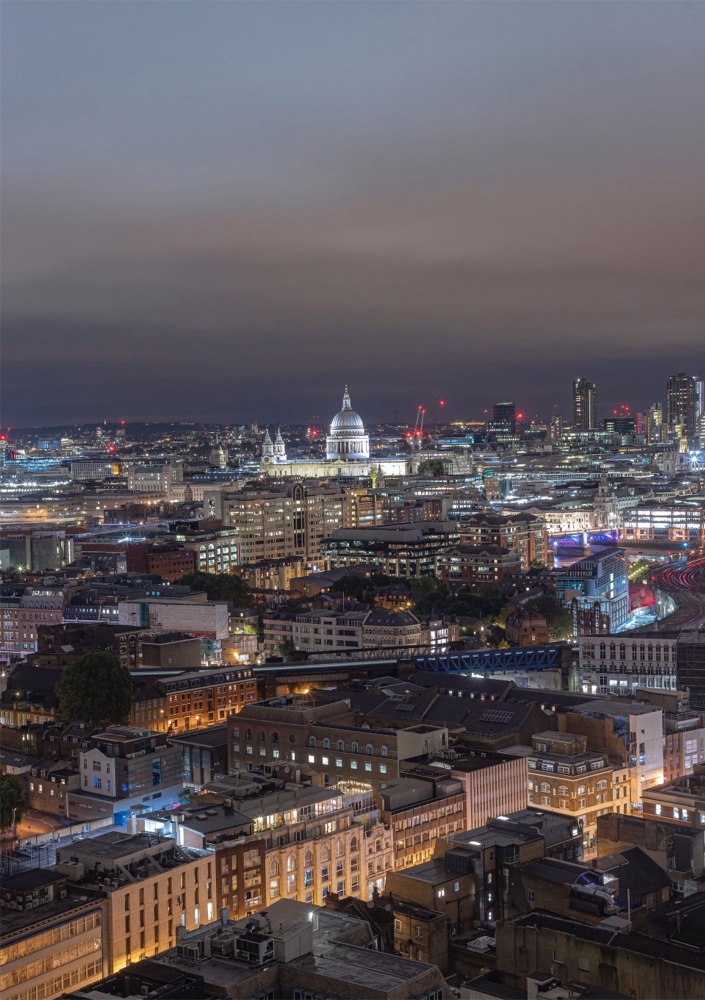St Paul's Cathedral
Home > Photos from England > London Gallery 1 > St. George the Martyr Church London

The London skyline was lit up like a small city of jewels beneath the velvet evening sky. Lights twinkled in the distance, illuminating the majestic St. Paul's Cathedral, grand and imposing despite the expanse that separated it from the photographer. The air was cold and crisp, and the only sound was the low hum of the city's hustle and bustle. 34 Long Lane, the spot from which the photographer was capturing the scene, had been carefully selected for this shot — it offered the perfect vantage point to capture the beautiful silhouette of the cathedral against the backdrop of the city below.
The photographer — let's call him Alex — stood in awe of the majestic monument before him, a feeling of peace and contentment washing over him. He held his camera steady and snapped his final shot of the evening, knowing that the moment, captured in that single photograph, would stay with him for the rest of his life.
And with that, Alex turned and made his way back home, the cathedral's beauty still dancing in his heart and mind.
St Paul's Cathedral
St Paul's Cathedral is an Anglican cathedral in London and is the seat of the Bishop of London. The cathedral serves as the mother church of the Diocese of London. It is on Ludgate Hill at the highest point of the City of London and is a Grade I listed building. Its dedication to Paul the Apostle dates back to the original church on this site, founded in AD 604. The present structure, dating from the late 17th century, was designed in the English Baroque style by Sir Christopher Wren. Its construction, completed in Wren's lifetime, was part of a major rebuilding programme in the city after the Great Fire of London. The earlier Gothic cathedral (Old St Paul's Cathedral), largely destroyed in the Great Fire, was a central focus for medieval and early modern London, including Paul's walk and St Paul's Churchyard, being the site of St. Paul's Cross.
The cathedral is one of the most famous and recognisable sights in London. Its dome, surrounded by the spires of Wren's City churches, has dominated the skyline for over 300 years. At 365 ft (111 m) high, it was the tallest building in London from 1710 to 1963. The dome is still one of the highest in the world. St Paul's is the second-largest church building in area in the United Kingdom, after Liverpool Cathedral.
Services held at St Paul's have included the funerals of Admiral Lord Nelson, the Duke of Wellington, Winston Churchill, and Margaret Thatcher; jubilee celebrations for Queen Victoria; an inauguration service for the Metropolitan Hospital Sunday Fund; peace services marking the end of the First and Second World Wars; the wedding of Prince Charles and Lady Diana Spencer; the launch of the Festival of Britain; and the thanksgiving services for the Silver, Golden, Diamond, and Platinum Jubilees and the 80th and 90th birthdays of Queen Elizabeth II. St Paul's Cathedral is the central subject of much promotional material and images of the dome surrounded by the smoke and fire of the Blitz. The cathedral is a working church with hourly prayer and daily services. The tourist entry fee at the door is £21 for adults (Summer 2022, cheaper if booked online), but no charges are made to worshippers attending advertised services.
The nearest underground station is St Paul's, which is 130 yards (120 m) away from St Paul's Cathedral.
From Wikipedia, the free encyclopedia.


